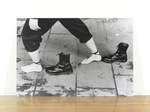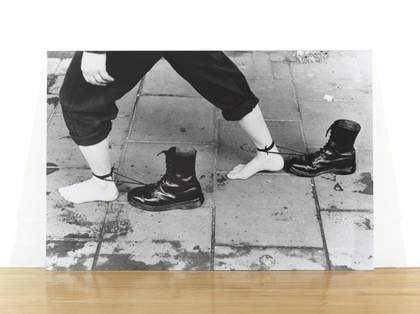You will need:
- Everyday objects (a few per table) – this can be anything you have around you, clothing, tools, equipment, food, stationery, books!
- Use what you have to hand or plan ahead and ask your students to bring in one or two objects from home


You will need:

Mona Hatoum
Performance Still (1985–95)
Tate
Your students don’t need to know anything about an artwork or artist to start exploring it.
Use these quick group activities to build their confidence and curiosity in sharing their first responses to the artwork. Some artworks they might like straight away, some they might not.
Discovering art can be new, exciting and sometimes confusing. There are no right or wrong ways to respond!
In pairs or as a group, take it in turns to imagine the artworks answering these questions and telling their story.
In pairs or as a group, use your body to respond to the artwork.
Performance Still 1985–95 is a photograph of a performance carried out in 1985 by artist Mona Hatoum. For nearly an hour, Hatoum walked barefoot through Brixton, London, with Dr. Marten boots tied to her ankles. By doing this, she used the movement of her body to explore ideas of strength and persistence, particularly when thinking about her experiences of racialisation and displacement, power and oppression.
As times change, the way we relate to different objects changes too, depending on our lived experiences. By using everyday objects in her artwork, Hatoum shares complicated and painful histories with her audience, giving them points of reference from which they can understand the stories they are being shown. For example, the Dr. Marten boots would have been an easily identifiable symbol of racism in the UK at the time of Hatoum’s performance, as they were worn by far-right National Front skinheads and it is likely that her audience would have understood the intentions behind the performance.
Mona Hatoum is a Palestinian-British artist. She came to Britain as a student in the mid-1970s, settling in London in 1975 when civil war in Lebanon made her return home impossible. Working with video and installation, she explores difficult themes such as violence, oppression and displacement, often referencing the human body.
Performance Still prompts us to think about how we relate to objects around us and the stories we can tell with them. This activity invites you to explore everyday objects and create performance art.
ADAPT
Are there any objects that you feel connected to? How can you tell different stories using these objects?
Alternatively, take photographs of each other holding, posing with or moving with your objects, then print out the images and create a display for your classroom. Tics and stims could become part of what you capture and celebrate too!
3. Think of a moment from your life that this object could connect to. For example, if you chose a book, maybe you have a memory of reading something in a particular place that is important to you. Be creative, use your imagination – this doesn’t need to be literal!
4. Think about how you could recreate that moment through a single movement using your object. Be inspired by Hatoum – you can move however you’d like, making a big gesture or a really small movement.
5. Practise your movement with a partner and see if they can figure out your story!
6. Is there anything you’d change about your movement? Could you add other objects to tell more of your story?
7. At the end of your lesson, share your performances with each other and celebrate the artworks you’ve just made!
What have you learned by storytelling through objects?
How could you continue exploring the objects further?
Extend
Using your school’s iPad or camera, take photos of each other carrying out your movements with your objects.
Think about where you will take the photo – what's in the background? How does that change the stories behind your movements?
Once you’ve taken your photos, share them as a class and talk about them together. Think about someone else’s photo – what do you think they are trying to tell you? Share these different stories with each other.
Explore the history of performance art and discover how this art form has offered artists a new way to express themselves creatively, often using just their bodies.
If you could create a performance from scratch, what would you want it to say? How could you use performance to explore a theme or topic you are interested in from a new perspective?
Making art is a powerful way to learn new skills, explore big ideas, and express ourselves creatively. Encourage your students to discover new materials, techniques and methods inspired by great artists at Tate.
2. Explore (10 minutes)
3. Make (30 minutes)